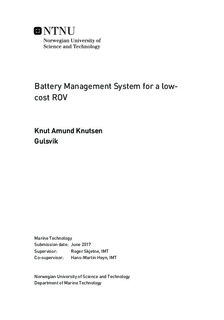Battery Management System for a low-cost ROV
Master thesis
Permanent lenke
http://hdl.handle.net/11250/2615036Utgivelsesdato
2017Metadata
Vis full innførselSamlinger
- Institutt for marin teknikk [3421]
Sammendrag
A combination of advanced State-of-charge (SoC), State-of-Health (SoH) and State-of-Power (SoP) estimation techniques have been combined into a novel scheme to ensure safe and efficient operation of a battery pack.
A battery model was chosen based on literature review and identified requirements for a BMS for a remotely-operated-vehicle (ROV) application. This revealed that a 2RC equivalent-electric-circuit (EEC) model provides the required level of accuracy, complexity of implementation and computational cost. Laboratory experiments where performed on a fresh cell in order to extract the parameters of the model. The relationship between open-circuit-voltage (OCV) and SoC was found by curve-fitting a custom function to the voltage data and measured SoC. A highly accurate OCV-SoC function v_{oc}(soc) is found to be crucial to ensure converge to correct SoC and open-circuit voltage, as it is the foundation of the model. The RC parameters $\beta$ is found through nonlinear greybox modelling using the Levenberg-Marquard algorithm. The model has problems fitting the data to 1RC model, so an extra RC-cicrcuit was added. The estimation results showed the parameters expected dependency on SoC. The effect of including this dependency and thereof also complexity was however not found necessary as the RMSE of output voltage only decreased 3.2mV.
The obtained battery model with the respective parameters showed good performance for cell measurement data obtained in the lab experiments. In order to maintain this performance for different operating conditions, a comparative study on different versions of Joint Extended Kalman Filters (JEKF) was performed.
All of the proposed JEKF's performed well in terms of SoC estimation, even for biased current measurements, decreasing total capacity and noise voltage measurements. For SoH estimation through total capacity estimation, a seperate Kalman filter running only at the end of a discharge cycle is suggested. This might be justified because of the operational profile of the ROV which utilize close to full SoC range.Since total capacity is such a slowly varying process, there is no reason to estimate it every second. \\ A novel approach of using SoP as a model-predictive control law saturating maximum power of the battery has been explored. While the accuracy of the SoP estimates are not validated, the concept shows great potential and should be implemented regardless of the choice of SoC/SoH observer.
